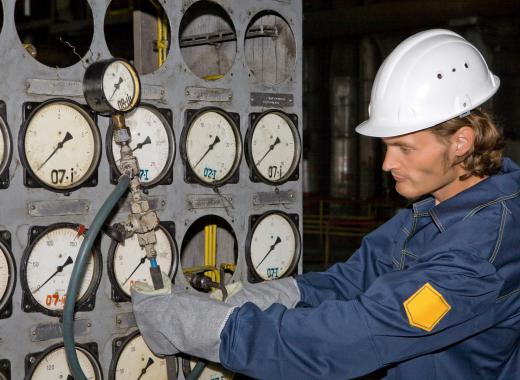What Is a Resistivity Meter?
A resistivity meter is an electronic device used to measure the flow of electric current through the ground from probes inserted at regular intervals. Resistivity is defined as the amount of resistance to current flow, therefore the device can determine different soil compositions based on the readings. These meters are used for soil surveys, locating ground water, and even surveying for underground structures.
When electrical current passes through dry soil, there is a very high resistance because the soil or dirt is not a good conductor. The presence of water can allow electrical current to pass relatively freely, and the resistivity meter will show much lower values. A series of probes can therefore provide a visual idea of the soil composition by preparing graphs from repeated measurements.

Four probes can be placed in a straight line, with current applied at the two outer probes and measured at the inner ones. This is known as the Wenner method, invented by Dr. Frank Wenner of the US Bureau of Standards, and is a common method for resistivity measurement. The probes or rods should have equal spacing with the distance between them being three to four times their length. A resistivity meter is designed to measure wider ranges of current and resistance than a standard electric multi-meter.
In addition to determining water content, electrical measurements also measure salts that contribute to corrosion. A resistivity meter is often used to measure soil conditions near buried pipelines and other metallic structures. Protective rods, called anodes, can be placed at regular intervals to reduce corrosion. The anodes corrode before the structure does, and any stray electrical currents are directed through the anodes to the ground.
Another use of soil resistance measurement is determining the efficiency of electrical grounding equipment. Electrical substations, transmission towers and buildings may have either electrical or lightning protection grounding rods. A resistance survey will help determine the best locations for grounding equipment and the efficiency of installed systems. Changes in resistivity over time can show when repair of grounding systems is needed due to corrosion or damage.
A resistivity meter can determine the location of underground structures or artifacts. The electrical resistance of soil changes with the introduction of open areas such as buried rooms or graves. An electrical resistivity survey is prepared by placing probes in regular patterns. Differences in the meter readings will show the presence of objects underground that are different from plain soil.
AS FEATURED ON:
AS FEATURED ON:











Discuss this Article
Post your comments